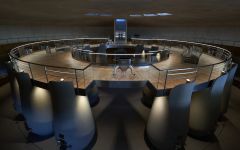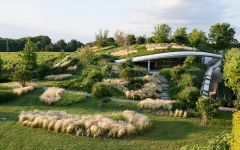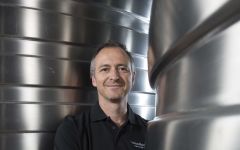Chateau Haut-Bailly La Parde de Haut-Bailly 2016
-
Jeb
Dunnuck -
Wine
Enthusiast -
James
Suckling - Decanter
-
Robert
Parker -
Wine
Spectator



Product Details
Your Rating
Somm Note
Winemaker Notes
La Parde Haut-Bailly 2016 shows an exceptional level of selection for a second label. In this 2016 vintage, it stands out for its impressive density and structure, as well as a great aromatic finesse. It offers an attractive floral perfume, followed with juicy dark fruits. It is a soft and powerful wine, with silky tannins which come together to showcase Haut-Bailly’s signature qualities of both balance and elegance
Professional Ratings
-
Jeb Dunnuck
As to the second wine of Château Haut Bailly, it too is fabulous stuff in 2016. A blend of 47% each of Merlot and Cabernet Sauvignon, with the balance Cabernet Franc, the 2016 Le Prade de Haut Bailly offers notable purity as well as medium to full-bodied notes of blackcurrants, dried herbs, flowers, and spice. It’s a layered, seamless wine from this estate that has no hard edges, beautiful balance, and a great finish. It’s already delivering loads of pleasure but will keep for 15+ years.
-
Wine Enthusiast
This second wine of Château Haut-Bailly offers a softer reflection of the power of the top wine. Generous tannins are already integrating with the rich fruits that come through strongly. The juicy blackberry character to this wine shows concentration. Drink from 2024.
-
James Suckling
The mineral and tar character with hints of white pepper is at the forefront of the nose here. The palate’s defined by a medium to full body, firm and silky tannins and a fresh finish. More phenolic than the 2015.
Barrel Sample: 92-93 Points -
Decanter
A firm wine at 81IPT, the tannins are a little tighter than the grand vin, although nothing is masking those supple black brambly fruits. From a blend of 47% Merlot, 47% Cabernet Sauvignon and 6% Cabernet Franc, representing 25% of overall production., aged in 30% new oak. Following Dubourdieu, his long-term colleagues Valerie Lavigne, Christophe Olivier and Axel Marchal are consulting.
Barrel Sample -
Robert Parker's Wine Advocate
The medium garnet-purple colored 2016 La Parde de Haut-Bailly comes bursting out of the glass with cassis, redcurrant jelly, fragrant earth and dried Provence herbs scents plus a waft of lavender. Medium to full-bodied, firm, grainy textured and packed with fruit, it delivers a long and mineral-laced finish.
-
Wine Spectator
Polished and open in feel, with a lovely beam of pure plum and raspberry puree flavors inlaid with light tobacco and toasty vanilla notes. Subtle mesquite detail shows on the finish. Ready to go too. Drink now through 2028.
Other Vintages
2017-
Wine
Enthusiast -
James
Suckling -
Robert
Parker - Decanter
-
Jeb
Dunnuck
-
Wine
Enthusiast -
James
Suckling -
Wine
Spectator -
Robert
Parker
-
Wine
Enthusiast -
James
Suckling -
Wine
Spectator







The vineyard of Haut-Bailly as we know it today began to take shape when the Goyanèche and then the Daitze family acquired and unified the best vine growing plots in the 1530s. The estate remained in the Daitze Family until 1630 when it was purchased by Firmin Le Bailly and Nicolas de Leuvarde, wealthy Parisian bankers and lovers of Graves wines.
Following substantial investments, the property continued to be passed down the Bailly family line until 1736, when Irishman Thomas Barton took the helm. His strong business network allowed him to spread word about the quality of Chateau Haut-Bailly at a time when French ‘claret' was beginning its rise to stardom in England and Ireland.
Throughout the 18th century powerful, well-connected and ambitious owners drove Haut-Bailly to new heights, including Christophe Lafaurie de Monbadon and his son Laurent who went on to become Mayor of Bordeaux in 1805.
In 1872, Alcide Bellot des Minières acquired the estate and constructed the imposing, stone chateau building that remains to this day. He pioneered a precise, science-driven approach to viticulture, becoming a figure of legend widely known as the 'King of Vintners'. Thanks to Alcide's incredible drive, Haut-Bailly experienced a remarkable golden age, commanding the same prices as the First Growths: Lafite, Latour, Margaux and Haut-Brion.
The purchase of Haut-Bailly in 1955 by Daniel Sanders, a Belgian negociant, opened up a new era. Daniel and his son, Jean, recomposed the vineyard, renovated the winery and took pains to select only grapes from the best vines for their grand vin. They succeeded in giving the wines a unique style and reputation, and Haut-Bailly recovered its image as a great wine on the international marketplace.
In July 1998 Chateau Haut-Bailly was purchased by American Robert G. Wilmers, chairman and CEO of the M&T Bank based in Buffalo, New York. A lifelong lover of Bordeaux Grands Crus, Bob was behind every strategic decision, ensuring that Haut-Bailly followed a path of progression and continuity whilst remaining ever-respectful of its heritage.
After Mr. Wilmers purchased the property, he first asked Jean Sanders to stay on board, and then Véronique Sanders, fourth generation, to serve as general manager, overseeing a far-reaching investment programme to modernise the vineyards, cellars, offices, and chateau itself.
For Bob and his wife Elisabeth, Haut-Bailly went well beyond a financial investment: it was a joint passion. Following the sad passing of Bob in December 2017, his family has taken over and will continue in his footsteps. Together with the management team, they are committed to continuing Bob’s work in the same spirit and energy as in the past twenty years. The many recently initiated and future projects will be pursued.
With the 2021 vintage, Chateau Haut-Bailly debuted a contemporary, custom-built winery which was completed at the end of 2020. The building allows them to carry out precision work in optimal conditions thanks to the space, natural light and technical innovation which are at the heart of the project.

One of the world’s most classic and popular styles of red wine, Bordeaux-inspired blends have spread from their homeland in France to nearly every corner of the New World. Typically based on either Cabernet Sauvignon or Merlot and supported by Cabernet Franc, Malbec and Petit Verdot, the best of these are densely hued, fragrant, full of fruit and boast a structure that begs for cellar time. Somm Secret—Blends from Bordeaux are generally earthier compared to those from the New World, which tend to be fruit-dominant.

Recognized for its superior reds as well as whites, Pessac-Léognan on the Left Bank claims classified growths for both—making it quite unique in comparison to its neighboring Médoc properties.
Pessac’s Chateau Haut-Brion, the only first growth located outside of the Médoc, is said to have been the first to conceptualize fine red wine in Bordeaux back in the late 1600s. The estate, along with its high-esteemed neighbors, La Mission Haut-Brion, Les Carmes Haut-Brion, Pique-Caillou and Chateau Pape-Clément are today all but enveloped by the city of Bordeaux. The rest of the vineyards of Pessac-Léognan are in clearings of heavily forested area or abutting dense suburbs.
Arid sand and gravel on top of clay and limestone make the area unique and conducive to growing Sémillon and Sauvignon blanc as well as the grapes in the usual Left Bank red recipe: Cabernet Sauvignon, Merlot, Cabernet Franc and miniscule percentages of Petit Verdot and Malbec.
The best reds will show great force and finesse with inky blue and black fruit, mushroom, forest, tobacco, iodine and a smooth and intriguing texture.
Its best whites show complexity, longevity and no lack of exotic twists on citrus, tropical and stone fruit with pronounced floral and spice characteristics.
